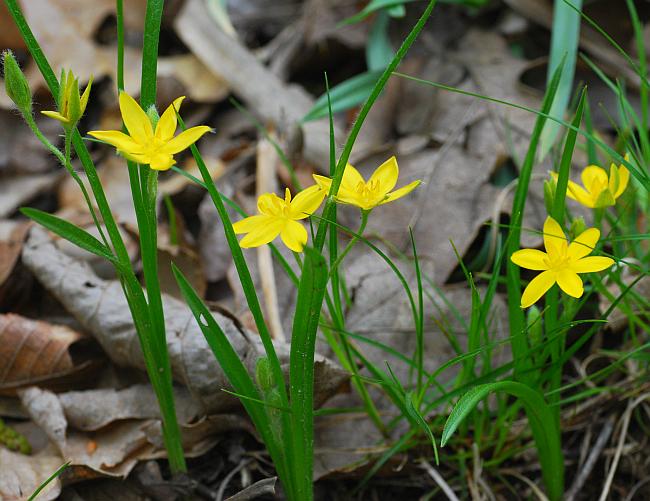Hypoxis hirsuta (L.) Coville
Yellow Star Grass

Native
CC = 5
CW = 0
MOC = 73
© SRTurner
Hypoxis hirsuta (L.) CovilleYellow Star Grass | |
 |
Native CC = 5 CW = 0 MOC = 73 |
© SRTurner |
|
Family - Liliaceae Habit - Perennial forb from a corm, lacking the odor of onion or garlic.
Stems - Erect, to 25 cm long, unbranched below the inflorescence, sparsely to densely hairy. Leaves - Basal, usually 2-6, linear, to 30 cm, 3 mm broad, with 5-9 main veins, sparsely to densely hairy.
Inflorescences - Terminal, irregular umbels of 2-6 flowers, sometimes reduced to a single flower, subtended by 1-2 small, linear bracts when young. Pedicels to 2.5 cm long, pubescent.
Flowers - Perianth 5-13 mm long, spreading, the sepals and petals attached to the top of the ovary, ovate to narrowly oblong or nearly linear, the inner (upper) surface yellow, glabrous, the outer (under) surface yellowish green in bud to usually yellow at flowering, hairy. Stamens 6, attached to the top of the ovary, free from the perianth. Filaments glabrous, 2-3mm long. Anthers orange, 2.1 mm long, sagittate. Style 1, short, slightly thickened near the tip, the stigma 3-lobed, the lobes receptive on the inner surface. Ovary inferior, with 3 locules, each with 3-5 ovules, hairy. Style 1.5mm long, glabrous.
Fruits - 3-6 mm long, ovoid, capsulelike but indehiscent, with papery walls.
Flowering - April - May. Habitat - Mesic to dry upland prairies, glades, exposed bluff tops, dry upland forests, fields. Origin - Native to the U.S. Lookalikes - None. Other info. - This little species is common in Missouri and easily seen even though it is quite small. It occurs throughout most of the state, also ranging across the eastern half of the continental U.S. and into Canada. It is easily recognized by its bright yellow flowers, grasslike leaves, and diminutive stature. The small yellow flowers open in the morning and typically wilt in hot sun. The amount of pubescence can be variable, as well as the size of the foliage and flowers. The seeds are covered with tiny bumps or spines, and anthers diverge in the lower half, giving the stamens an "arrowhead-like" appearance. Photographs taken at the Piney Creek Wilderness, Mark Twain National Forest, Barry County, MO., 4-9-01, at Earthquake Hollow, Callaway County, MO., 4-22-04, and at Bibb County Glades, Bibb County, AL., 5-1-05 (DETenaglia); also at Pickle Springs Natural Area, Ste. Genevieve County, MO, 5-3-2008, Valley View Glade Natural Area, Jefferson County, MO, 4-10-2010 and 5-6-2018, and Shaw Nature Reserve, Franklin County, MO, 5-26-2022 (SRTurner). |